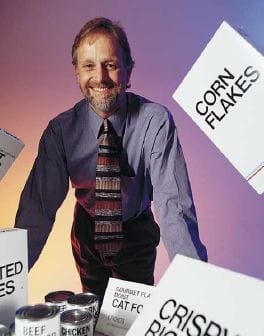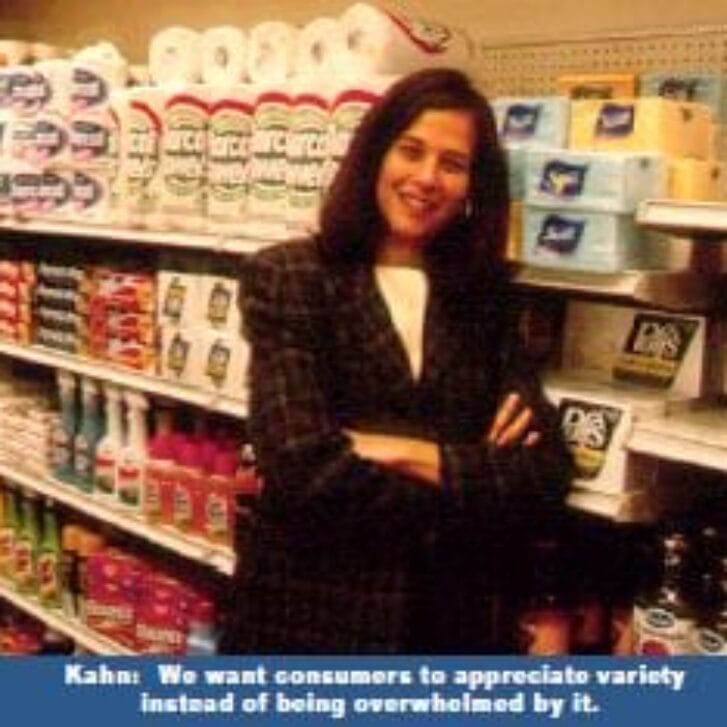Stephen J. Hoch, the John J. Pomerantz Professor of Marketing, remembers the time he bought a huge box of store brand, or private label, cheerios for his two daughters. “They took one bite and said to me, with great indignation, ‘Dad! These aren’t real cheerios! What are they? The store brand?’”
It was a story that Hoch has repeated several times to executives in the food marketing business, the point being that retailers should never offer a bad quality store brand in any of their product categories because a single bad product can tarnish the store’s image. “It’s one reason Disney is very conservative about how, and to whom, they are willing to license their characters,” says Hoch. “The company knows that their good name on a bad product can severely reduce brand equity.”
Hoch, as it turns out, knows something about store brands and Disney, and a lot about the whole process of shopping.
“Shopping sounds like such a mundane activity,” he says, “but it goes back to the reason I returned to school for my PhD. I am interested in studying how people — whether they are consumers or managers — make decisions.”
Specifically, Hoch — who earned his undergraduate degree in biology from Stanford, his MBA in marketing from UCLA and his PhD in marketing, with a minor in psychology, from Northwestern — is interested in how consumers decide what to buy, and how those decisions affect retail merchandising, pricing and promotion strategy.
Most recently, he has looked into the impact of private label merchandise on customer/competitor relationships and has researched strategies adopted by the pharmaceutical industry to cope with price pressures from the health care system. He has studied the effects of Internet shopping on retailers and manufacturers, and he is an expert on such subjects as price elasticity, scanner data, shelf management, consumer preference and the psychology of forecasting.
It doesn’t hurt that Hoch actually enjoys the shopping experience. A self-described house-husband who likes to cook and garden, he is adept at cruising the aisles of grocery and hardware stores. And while he doesn’t particularly relish clothes shopping, he has practically trademarked the Hawaiian-shirt-plus-earring look around Wharton, a fashion statement inspired by his southern California upbringing and what he calls a desire “for a certain level of uniqueness.”
After earning his MBA in 1976, Hoch joined the consumer products division at Walt Disney Productions, the second MBA the company had ever hired, and within 18 months was running Disney’s recorded music division. During his tenure, the division released “Mickey Mouse Disco,” an album set to the music of Saturday Night Fever. The album went gold and, with catalogue and character tie-ins, earned millions for Disney.
“I was given a lot of responsibility and the opportunity to run a company,” Hoch says. “I had to think about customers, about how to develop new products and about what goes into purchasing decisions. It was a terrific job.”
He left Disney in 1979 to pursue his doctoral degree and in 1983 joined the faculty of the University of Chicago Graduate School of Business where he taught for 12 years before coming to Wharton in 1995.
While at Chicago, he directed a five-year study on micromarketing that involved a Chicago grocery chain called Dominick’s Finer Foods and 20 leading consumer packaged goods companies. He and his research colleagues took “gigabytes of scanner data that retailers were collecting, and still are, to try and understand how managers make decisions.”
Once you understand that, Hoch says, then you can take steps to improve managerial and company-wide performance.
While managers’ decisions are important, he adds, the kinds of decisions consumers make in everyday purchasing are not. “What brand of detergent I buy is not going to have a big implication one way or another. These are low-stakes decisions. But because millions of them are being made every day, they have huge implications for retailers and manufacturers who are trying to meet consumer demand.”
Hoch is also involved in the Decision Processes Interdisciplinary program, which includes researchers from throughout the University in such areas as psychology, medicine and Wharton’s marketing and operations and information management (OPIM) departments. “We all have a basic interest in issues related to decision making,” says Hoch. “What’s interesting is that everyday people as well as professional decision makers don’t actually make decisions the way they should if they want to optimize their performance.”
The program, which also facilitates interdisciplinary research for PhD students, is engaging in what Hoch terms “‘inreach,’ which I define as making sure we reach across departments and disciplinary boundaries within the university to tap the creativity and inspiration that comes from looking at the same problems but from different angles. This kind of effort is one of the big bonuses of being at Wharton. It allows me to interact with people who can stimulate my own thinking. Hopefully I can do the same for them.”
The ABCs of Soups
The five-year study of Dominick’s was a hands-on project, to say the least. “We used Dominick’s 86 stores as a kind of living lab and ran about 350 different kinds of experiments on all aspects of what I call ‘the front door,’ where the store meets the consumer,” Hoch says. “We looked at how products were displayed and organized on the shelf; at pricing and promotion; and at which products were carried or not carried and how that affected sales and profits, among other things.”
The research team asked whether a traditional supermarket retailer — one with many different sales going on every week — could effectively shift to a pricing strategy called EDLP, or everyday low pricing. Its answer was no. “Very few supermarkets actually pursue a pure EDLP strategy because it is hard to make work,” Hoch says. “The only two success stories in the retail industry are Home Depot and Walmart, both of which offer consistently low prices and no weekly promotions. It has allowed these chains to drive a lot of the competition in their respective markets out of business and it supports my intuition that in any market there is only one retailer that can really have a low price image.”
In the Dominick’s study, Hoch and his colleagues tried a number of experiments aimed at understanding consumer purchasing behavior. For example, they rearranged — by type — the 100+ cereal brands that supermarkets typically stack on shelves according to their manufacturer, to see whether that re-grouping would increase sales. “We put all the raisin brans together, all high fiber cereals together, all fruit cereals together, etc., and we did the same thing with soups, except that we arranged them alphabetically,” says Hoch.
To the researchers’ surprise, sales went down five percent. “We realized that by making it easier for consumers to find certain items, it lessened the chance that they would come across, and buy, an additional item or items that they may not have originally planned to purchase,” Hoch says. “In other words, opportunistic sales dropped.”
One of the most significant conclusions reached by Hoch and his team during the study was that micro-marketing — i.e. customizing assortment and pricing to a particular geographic location — was difficult for supermarkets to implement.
“The potential for doing real micro-marketing, using stores as the delivery device, is probably not profitable,” Hoch says. “The cost and control systems that retailers would need to implement micro-marketing are significant, especially as related to assortment, while the returns are modest at best.”
Shopping the Net
When Hoch decided to rent a ski condominium for his family this winter, he did what many Net-savvy consumers these days do. He checked out the Internet. “We all know the Internet offers vast new sources of information,” Hoch says. “If you are interested in buying a car, for example, you can visit several sites that provide invoice prices, specifications in terms of performance, physical characteristics and so forth. You don’t have to leave your office or home for this information, and it’s all free and easy to access, at least for now.”
Part of the reason it’s so easy, of course, is that almost anybody — retailers, manufacturers, individuals — can create web sites offering information on just about every product and service imaginable, or offer the product/service itself. At the same time, search engines get increasingly more sophisticated in terms of helping the consumer locate, process and compare data. Middlemen, whose jobs have traditionally been to broker information, are in many cases no longer necessary.
The result of this disintermediation says Hoch, is that eventually “you the consumer become inundated and confused from the sheer overload of data. It’s like walking into a Chinese restaurant that offers 400 different items. Unless you are with someone who is an expert on the restaurant, you have a problem. You don’t want that many choices. You want some subset of those choices that are good. So you might ask the waiter for a recommendation or look for combination plates.
“At some point the cost of information increases when you get too much of it,” Hoch says. “Right now manufacturers provide data because it costs next to nothing to do so. Should there, in fact, be a higher cost of providing information — or if manufacturers perceive that this huge inundation of data on the Internet becomes too burdensome to consumers — then the flow of data might decrease. At the moment, no one knows how the pricing structure or provision of information will evolve.”
The bottom line, says Hoch, is that everyone is willing to pay for convenience, even people who are income-constrained, because they have less and less time to devote to shopping. “People used to spend four hours a month mall shopping; in the last 20 years, it’s gone down to two hours.
“Consequently, going shopping on the Internet is not necessarily a good use of someone’s time unless the person is going to make a career out of consistently buying a particular product … I spent six hours looking for that ski condo on the Internet. Was it worth my time? We’ll see how good the condo is … It may be that next time it will be more efficient for me to get someone else to be my agent.”
Store Brands: How They Stack Up
Hoch’s most recent research has taken him into the world of store brands and private labels — terms that refer to brands which are available only at a particular store or chain. The products tend to be less expensive than the national brands, but not necessarily of lower quality.
In supermarkets, drugstores and department stores, store brands typically make up 15 to 20 percent of sales, Hoch says. The bigger department stores, like Nordstrom’s or Bloomingdale’s, carry upwards of 20, sometimes even 50, different private labels, not necessarily affiliated specifically with the store.
Hoch’s main interest has been in the packaged goods (food) area, partly because he has had access to tremendous amounts of scanner data from both manufacturers and retailers. He is especially intrigued by analgesics.
“In the headache relief category, about 25 percent of sales come from the store brand, which tends to be significantly cheaper than national brands,” he says. “Yet given that both categories are chemically identical and in some sense regulated to be that way, I was surprised that 100 percent of sales are not store brand.”
In looking at the whole issue of why store brands do well or don’t do well, Hoch originally focused on quality. Now, after several years of research, he has identified at least three parties that have a big impact on whether or not a store brand succeeds.
The first is the consumer. “Consumers care about convenience and quality,” Hoch says. “But they also care about value. They don’t want to give up quality and they want to pay what they think is a good price. Clearly store brands are positioned for that value orientation.”
The second influential party is the national brand. These manufacturers — because of substantial resources, product innovation capabilities, big advertising budgets and the ability to offer a broad assortment of sizes, flavors, colors, etc. — are able to make life difficult for the store brand. “National manufacturers can always offer a bigger assortment than any individual retailer because they sell to many retailers instead of just one,” says Hoch. “They can easily crowd out private labels.”
The third party at this table are the retailers themselves, “who, I’ve discovered over the past few years, are the biggest determinant of how well a store brand does,” Hoch says. “When a retailer is selling its own brand, not only is it a retailer, but also a marketer and a manufacturer in the sense that it has to source the products, make them, warehouse them, promote them and develop new ones.”
Clearly the relationship between the manufacturer and the retailer is dramatically altered. A manufacturer sells a national brand to a retailer, who then resells it to the consumer. The retailer in that case is the manufacturer’s customer. But once the retailer introduces a store brand, especially a successful one, the retailer is not just the manufacturer’s customer but also its competitor.
“I’ve looked, in a strategic sense, at how the national brand/manufacturer and the store brand/retailer should think about this new kind of relationship,” says Hoch. “One view is that the manufacturer should think of that retail brand as simply another brand they compete against. But for a long time manufacturers didn’t have that view. They saw these private brands as cheap, inferior goods bought by income-constrained people they didn’t want to serve.
“Now that private labels are actually much higher quality, it’s a different story. It’s a more complicated and ambiguous relationship that calls for new approaches. At some point, the national brand needs to figure out how to coordinate and coexist better with the store brand. I call it, ‘When your customers are also your competitors.’ It could even be thought of as sibling rivalry.”
This dynamic, Hoch says, takes place in many industries and not just on the retail level. “Oftentimes in the high-tech area, for example, you have one manufacturer selling a key component to another manufacturer, who in turn is selling the same end product that the original manufacturer is selling.
“The first manufacturer can take a number of different approaches. It can simply refuse to sell products to competitors. It can engage in ‘search and destroy’ tactics to destroy its competitor. Or it can acknowledge that in the new business order, cycle times are very fast and relationships are in a constant state of evolution. A company that is your competitor today may become a customer tomorrow or may even become a part of your company. So trying to sell more, steal more market share or drive someone else out of business may not be the right approach.”
Hoch’s research has shown that not all manufacturers will be affected equally. “For the lead manufacturer in a particular product category, there is not much of a downside to competing with store brands. For non-leaders, it’s more problematic because in some sense the store brand is like a second-tier national brand. One approach is for the manufacturer to become a manufacturer of store brands. This is not a common occurrence in the packaged goods industry — except for commodity businesses, like salt, and products based on continuous process technology, like paper — but it is in the generic drug industry.”
Hoch recently did a major study looking at which retailers do well in this whole area and which don’t. “One conclusion I reached is that if the retailer is willing to put its own name on the package rather than a made-up name, sales increase. This approach leverages off of, and makes it clear, what the identity of the product is. A retailer can benefit from that association.”
In his current research, Hoch is applying his knowledge about store brands to the generic drug industry, a product group which has been seriously affected by managed care’s cost containment pressures as well as consumers’ increasing sophistication about their own health care. “The payment system has made it in consumers’ best interest not to treat health care decisions as mundane,” he says.
One notable development has been generic drugs’ increase in market share over the last 10 years. “The U.S. Food and Drug Administration recently told the top 200 managed care organizations that it knows of no instance where an FDA-approved generic drug is not as good as the prescription branded item,” says Hoch. “If I were a drug manufacturer, I would realize that the handwriting is on the wall. And in fact, they have realized it and are taking steps to deal with this.
“First, whereas in the food business almost no leading national brands manufacture store brands for retailers, in the pharmaceutical business many of the drug companies are also drug retailers. Case in point: Medco is a big mail order drug firm owned by Merck. Second, 70 percent of generic drug manufacturing capacity here in the U.S. is owned by the major pharmaceutical companies. They, unlike other businesses, know they have to vertically integrate.
“What’s fun about being an academic,” adds Hoch, “is learning what is happening in one domain and seeing if it applies to another. In the case of brand names and pharmaceuticals, I started out at first assuming that what I know about the packaged goods industry would apply to generic drugs as well. Sometimes it does and sometimes it doesn’t. The challenge is to figure out the differences.”


























